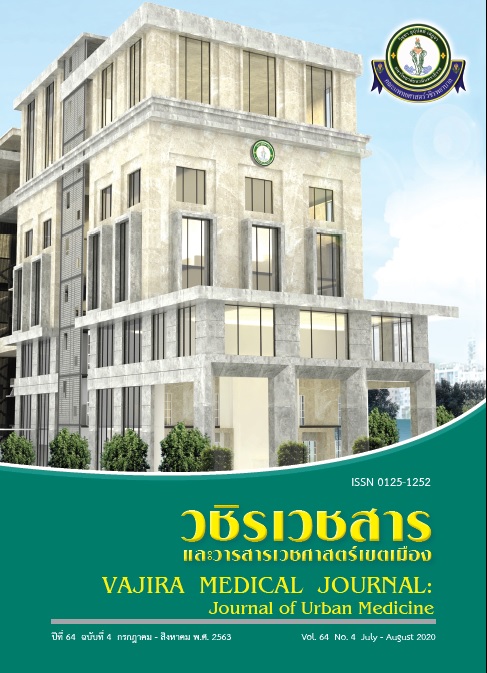Knowledge and Behavior of Contact Lens Wear in Medical Students and Medical Residents in Vajira Hospital
Main Article Content
Abstract
Objective: To determine knowledge and behavior of contact lens wear in medical students and medical residents in Vajira hospital.
Methods: A cross-sectional study using questionnaire was conducted among medical students and medical residents who wore contact lenses within the recent one year in Vajira hospital.
Results: A total of 660 (480 of medical students and 180 of residents) were recruited in this study. Twenty-four percent in medical student group and 17% in resident group wore contact lens in recent one year. The majority was female in both groups (79.3% and 80.6%, respectively). The average age was 21.4 years in medical student group and 27.8 years in resident group. The main reason for wearing contact lens is visual correction (67.3%). Approximately sixty percent in both groups wore monthly soft contact lens following by daily disposable lens (43.5%). Six improper contact lens compliance and care practices were reported as sleeping with their lens (22.6%), swimming with lens (26.5%), topping off lens storage solution (20.0%), not cleaning lens case daily (57.7%), prolonged wear over replacing schedule (18.4%) and no rubbing and rinsing (33.7%). Seventy-three percent in medical student group and 48.4% in residency group were classified as good behavior. The prevalence of good contact lens behavior in medical students were significantly higher than that of medical resident (p=0.013). However, the majority of participants in both groups were categorized in good knowledge (p=0.297). In all participants, we found statistical significant different between behavior and knowledge (p=0.001)
Conclusion: The majority of participants in both groups have good knowledge. However, medical student group has better behavior in contact lens wear and care compare with medical resident group.
Downloads
Article Details
References
Moreddu R, Vigolo D and Yetisen AK. Contact lens technology: From fundamentals to applications. Adv Healthc Mater. 2019;8(15):e1900368
Barr JT. Contact Lens Spectrum's annual report of major corporate and product developments and events in the contact lens industry in 2004, as well as predictions for 2005 [internet]. Contact Lens Spectrum.2005[cited 2019 Oct 16]. Available from: https://www.clspectrum.com/issues/2005/january-2005/2004-annual-report
Cope JR, Collier SA, Rao MM, Chalmers R, Mitchell GL, Richdale K, et al. Contact lens wearer demographics and risk behaviors for contact lens-related eye infections-United States, 2014. MWWR Morb Mortal Wkly Rep 2015;64(32): 865-84.
Konne NM, Collier SA, Spangler J and Cope JR. Healthy contact lens behaviors communicated by eye care providers and recalled by patients- United States, 2018. MWWR Morb Mortal Wkly Rep 2019;68(32):693-7.
Efron N, Nichlos JJ, Woods CA and Morgan PB. Trends in US contact lens prescribing 2002-2014. Optom Vis Sci 2015;92(7):758-67.
Arumugam AO, Rajan R, Subramanian, Mahadevan R. PROSE for irregular corneas at a tertiary eye care center. Eye Contact Lens 2014;40:71-3.
Tan DTH, Pullum KW, Buckley RJ. Medical applications of scleral contact lenses: 1. A retrospective analysis of 343 cases. Cornea 1995;14:130-7.
Walline JJ, Long S, Zadnik K. daily disposable contact lens wear in myopic children. Optom Vis Sci 2004;81:255-9.
Chharm J, Cheung SW, Cho P. Practitioners’ analysis of contact lens practice in Hong Kong. Cont Lens Anterior Eye 2010;33:104-11.
Morgan PB, Efron N, Helland M, Itoi M, Jones D, Nichols JJ, et al. Demographics of international contact lens prescribing. Cont Lens Anterior Eye 2010;33:27-9.
Lim CHL, Stapleton F and Mehta JS. Review of contact lens-related complications. Eye & Contact Lens 2018;0:1-10.
Alipour F, Khaheshi S, Soleimanzadeh M, Heidarzadeh S and Heydarzadeh S. Contact lens-related complications: A review. J Ophthalmic Vis Res 2017;12(2):193-204.
Arshad M, Carnt N, Tan J, Ekkeshis I and Stapleton F. Water exposure and the risk of contact lensrelated disease. Cornea 2019;38(6):791-7.
Sauer A, Meyer N, Bourcier T. Risk facots for contact lens-related microbial keratitis: A case-control multicenter study. Eye & Contact Lens 2016;42(3):158-62.
Khan MH, Mubeen SM, Chaudhry TA, Khan SA. Contact lens use and its compliance for care among healthcare workers in Pakistan. Indian J Ophthalmol 2013;61(7):334-7.
Ibrahim NK, Seraj H, Khan R, Baabdullah M, Reda L. Prevalence, habits and outcomes of using contact lenses among medical students. Pak J Med Sci 2018;34(6):1429-34.
Leeamornsiri S, Titawattanakul Y. Comparative knowledge and behavior of contact lens care between medical and non-medical students.J Med Assoc Thai. 2015;98 (suppl. 3):S16-23.
Boyd K. How to Take Care of Contact Lenses [Internet]. American Academy of Ophthalmology; 2019[cited 2019 Nov 5]. Available from: https://www.aao.org/eye-health/glasses-contacts/contact-lens-care.
Wu Y, Carnt N, Stapleton F. Contact lens user profile, attitudes and level of compliance to lens care. Cont Lens Anterior Eye. 2010;33(4):183-8.
Gyawali R, Nestha Mohamed F, Bist J, Kandel H, Marasini S, Khadka J. Compliance and hygiene behavior among soft contact lens and wearers in Maldives. Cli Exp Optom. 201497(1):43-7.


